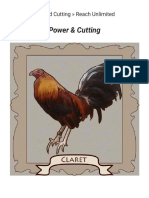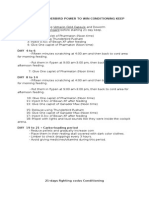Conditioning of Asil
Conditioning of Asil
Uploaded by
Worrenbuffet RangCopyright:
Available Formats
Conditioning of Asil
Conditioning of Asil
Uploaded by
Worrenbuffet RangOriginal Description:
Original Title
Copyright
Available Formats
Share this document
Did you find this document useful?
Is this content inappropriate?
Copyright:
Available Formats
Conditioning of Asil
Conditioning of Asil
Uploaded by
Worrenbuffet RangCopyright:
Available Formats
CONDITIONING OF ASIL
by Suresh Chilakalapudi
from Andra Pradesh (India
Cockers of today are more knowledgeable and generally better
educated, with more available information, than ever before.
But, while most cockers are great students of experience, as a
rule, they do little to actually study genetics and nutrition with
an eye toward improving the ability and performance of their
fowl. This conditioning method is an attempt to enable many
cockers to "catch up" with the latest scientific developments in
nutrition and training. The research, the studying, and the
experimentation have been done for you. This keep can work
for you. I have read doens of keeps, and while I have not seen
one written in the last ten years that would actually be
detrimental to your fowl, most have been fairly similar as to
feed and work. !ou will find that this keep is different in its
approach, than any you have ever used. To be successful, you
must follow this keep closely, in "uantity of feed and work,
and in type of feed and timing. This conditioning method is
based on the latest studies concerning athletic competition,
and what are cocks except athletes# The principle behind it is
known as "carbohydrate loading". To understand fully how
this keep works, you should know a little about nutrition and
its effects. $o you can understand the ideas involved, I will try
to simplify them. The amount of energy that a muscle will be
able to produce depends on the amount of "glycogen" stored in
that muscle. %lycogen is a chemical that serves as fuel for the
muscle. The more glycogen present in the muscle, the longer
that muscle will be able to act effectively. $tudies have shown
that if glycogen stores are depleted by exercise and a low
carbohydrate diet, then replaced by rest and a high
carbohydrate diet, the muscle can store twice as much
glycogen, or energy, as it had originally. &o one needs to tell
you what this means in practical terms' your cock will hit
harder, and more importantly, will be able to do it much
longer than he would have otherwise. (e will maintain that
deadly punch for a greater period of time. I will explain about
carbohydrates, proteins and fats in more detail when we get to
the sub)ect of feed. *inally, let me say that this is the closest
thing to a workingman+s keep that you can find. It does not
re"uire ,- hours a day to be effective. The maximum time
needed would be I to - hours in the morning and the same in
the evening. The "uantity of the time spent with your show of
cocks is not as important as the "uality of the time. .ake sure
that your time is well organied and efficient. This keep does
re"uire good cocks in good health cocks that are well bred and
have been fed and cared for properly all their lives. There is no
keep, and especially, no substance, that will make up for lack
of care. $o if you bought this keep because you have been lay
your cocks are in poor health from lack of care then you
cannot expect this conditioning method, or any other, to do
them any good.
/re01eep# 2hat+s That# .y feeling on this sub)ect is that our
cocks should be in a pre0keep all their lives well fed, but at
approximate fighting weights, worm free and deloused. I hope
you don+t have cocks that are any other way. I have fought
cocks off strings, out of fly pens and out of holding pens with
no appreciable difference in performance when this keep is
used for the last fourteen days. The important thing to
remember is that fowl are like people, in that they become
bored with the same surroundings. 2henever possible, rotate
cocks on a regular basis from fly pens to holding pens to string
walks. This will keep the cocks active and alert and prevent
them from becoming coop0stale. (andle your cocks often,
except in moulting season, to tame them and to determine
their weights so that their feed rations can be ad)usted
accordingly. I cannot overemphasie the fact that you should
put up only those cocks that are gentle and well mannered.
3ife is too short to fool with manfighters besides, it is my belief
that most manfighters are not truly game. (owever, don+t
confuse manfighters with nervous, high0strung fowl. 4lso,
many otherwise gentle cocks will hit back if mishandled or
when they are becoming sharp during the keep. 3ike boxers,
cocks in training love to snap a few punches at an available
target. In summary, )ust let me say that if a cock doesn+t gentle
down, doesn+t stop hitting or pecking when picked up, after a
week+s gentle handling, don+t consider him for a keep. 1ill him,
breed him 5if you are a fool6, but don+t put him up to fight.
$ince I am on the sub)ect, I+ll attempt to give you a good all
around feed routine, as well as a worming and delousing
schedule. !our daily feed for fowl on your yard should consist
of approximately 778 carbohydrates, ,78 protein, and 9:8
fat. $ince most laying mash is ,-8 to ,78 protein, you will
need to supplement the protein, unless you use the -: to 9:8
protein lay pellets offered by some feed stores. 4 good all0
around feed, and one that is as cheap as possible without
sacrificing "uality, is one part scratch 5which consists of
cracked corn and wheat6, one part -:8 laying pellets and one
part soaked oats. *or those cockers in the less temperate areas,
substitute whole corn for scratch in the winter. $ure, you can
buy more expensive feeds, but for a good sound all0purpose
feed, this mixture can+t be beaten. 4s for supplementing
protein, in moderation, you can use "trout chow", fish meal, or
even some high protein dog food such as %aines. But always
remember use these in moderation. Because, after all, you are
feeding chickens, and the closer you stay to a natural diet, the
better off you will be. 4 lot of fancy feeds will )ust upset a
fowl+s digestion. The opinions on amounts and times of feeds
would fill a book much larger than this. 4d)ust your feed in
accordance with the weight of the cock. 2hether you feed once
or twice daily depends on so many variables, I wouldn+t even
begin to try to dictate to you climate, types of pens, breeds of
fowl. %o with what works best for you. ;ne hint though, if you
have rather severe winters, make sure your cocks are fed as
close to dark as possible, the more corn the better, if this is a
second feed. It has been my experience that a cock with a full
crop can stand those cold nights much better than one that is
empty. 4s for worming and delousing get on a regular
schedule. If you have string walks, change the leg bands every
$aturday or $unday or whatever, )ust do it regularly. The same
goes for worming and delousing. *owl should be wormed and
deloused every month. In fact, I often delouse and worm any
time I have an occasion to catch one of my fowl running loose
on the yard. 4ny number of good products are available for
getting rid of lice.
Sparrin!
$parring can be a valuable tool for the cocker if done properly.
*irst, it is a tool for selection it allows the cocker to get some
idea of how a cock will fight. $econdly, a cock can learn some
things during the course of a session, good habits as well as
bad. Thirdly, sparring can be a valuable outlet for a cock+s
pent0up energy, allowing him to vent his rage and delay his
coming on point too early. $ome cockers use a catch cock and
attempt to "teach" a cock to hit at a cock+s tail even if he can+t
see his head. 4lso, some cockers tie a catch cock+s legs to see if
he will score on a down cock. I am doubtful if either of these
practices does the slightest bit of good, because I think the
aggressiveness of the cock is determined in the brood pen.
(owever, cocks, to a certain degree, can be taught to score
"uickly. This is the way. *irst, bill your cocks really well, flush
them and set them down close together, close enough so they+ll
get at one another very fast. 3et them have a good pitting,
enough to make them really mad, but don+t let them wallow
and break feathers. 4fter a ,7 second rest, flush them and set
them down about three feet apart. &ow, here is the important
part' when the cocks break, catch them immediately. Then
without rest, set them down 7 feet apart, let them break and
catch them. This time set them down < feet apart, let them
break and catch them. $et them down again < feet apart and
this time let them mix it up good. The purpose of this type of
sparring is simple' the cocks will begin to score more "uickly
and break higher. 4lso, you are not giving them enough time
to get tired and start ducking. If you let cocks spar until they
are very tired, they will learn to duck really "uickly, and this
habit must be avoided.
"ork
To attain maximum condition, a cock must be worked, and
worked hard. &ot all this work should be forced work, or
hand0work0most of it should, in fact, be natural work, the kind
a cock will do in a good fly pen with litter. (e will scratch and
fly up and down many times a day, complementing the
handwork you give him. I feel that it is impossible to get a cock
"muscle0bound" as some keeps would allow you to believe. It
is "uite possible to make a cock sore and stiff by overwork.
That is why this method allows a cock to "rest up" from his
conditioning program two full days before his fight. This "rest"
period serves several purposes. *irst, if the cock has sore or
stiff muscles, this time allows those muscles to regain their
original elasticity, yet retain the strength that has been
developed. $econdly, blood sugar begins to rise with the
decrease in work, beginning the pointing process. Thirdly, it
allows for the glycogen content in the muscles to increase.
$ome cocks will not be able to take the work of this
conditioning program. That in itself should give you some idea
as to whether your cocks are really "uality fowl. It has been my
experience that truly well bred cocks won+t fold under the
pressure of the work. =ather, they will rebound and thrive on
such activity, eager to work. 2hile realiing that volumes
could be written on this sub)ect alone, I think that it is
sufficiently important to touch on at least the ma)or points. In
fact, I believe that the ma)ority of 90, and >0, derby scores that
you see can be attributed to the lack of attention that most
cockers pay to this chore. 4fter all, your derby show is only as
good as your worst cock. If you approach the selection of your
derby show with the attitude that "2ell, this cock isn+t so good,
but maybe I+ll get lucky and meet another weak cock," then
you might as well stay at home. 4lways select the best cocks
you have to condition. !our first step in selecting is to examine
the overall health of the cock. ?yes should be bright, feathers
slick and oily, and he should )ust give off an impression of
active vitality. ?xamine feet and legs for sores or bumbles, the
breastbone for sores, and the mouth and head for blisters.
Check to make sure the cock is lice0free. (e should, in your
)udgment, be within two ounces of fighting weight. It would be
difficult to take more than that off in two weeks without
weakening the cock, or put more than two ounces on with a
rigorous training schedule. Check for broken wing or tail
feathers. @o not fight cocks with badly broken feathers. *or a
bent feather, where the shaft is bent but not broken, carefully
straighten the shaft, and apply a small piece of tape to the
feather. Asually, this will prevent further damage, at least
temporarily. If, in your opinion, the cock is in good health and
near his actual fighting weight, then set him aside as a definite
possibility. 4fter you have narrowed down your selections to a
workable number, weigh them, match according to weights,
and spar. This is where the real selection process takes place.
The good selector will be able to separate the duds from the
aces, or at least the good cocks from the poor ones. If possible,
have two other people actually pit the cocks, so you can be free
to observe. 2atch how the cocks move, where they are aiming
their licks, how accurate they are. 4re they well balanced, do
they land0.in position to hit again, do they have to have a bill0
hold to hit, do they duck, are their licks delivered with snap#
@uring the rest periods, how hard are they breathing# Is either
rattling# The answers to these "uestions should determine
your choices. (ow many cocks to actually put up is a decision
you must make, although this may be determined by the
number of your available cocks. I would personally hesitate to
enter a conditioning program without at least two cocks more
than were needed. *or example, for a 70cock derby, I would
put up seven or eight. If you put in two hard weeks of work on
a show of cocks, it is heartbreaking to have one of your cocks
come down with a cold the day before the derby and have to
miss it. =emember .urphy+s 3aw' if anything can go wrong, it
will, and at the worst possible momentB $o, be prepared. I
can+t tell you how many times this has happened to me. 4bout
three years ago I had up six stags for a 7 stag derby. The
morning before the derby I went to load my stags, and lo and
behold, one stag was beat up, slip0bill and bloody, and one
other was missingB 4fter much head scratching, I finally0
figured it out. 2hat happened was this' the evening before the
derby, one stag had gotten out of his holding stall probably I
hadn+t latched it securely and immediately began to fight with
the closest stag through the door. 2hen darkness fell, the stag
that was loose had stopped fighting and wandered outside 5the
door of the cockhouse was open for ventilation6, into the
woods0where he either died or was eaten by varmints. To
make a long story short, determined to fight in the derby, I
picked a stag off a string walk, loaded up and left. 1now what
happened# !ou guessed it. I won four and lost one the
substituteB I still tied for the derby, but that one fight cost me
about ,::: in prie money. $o don+t let it happen to you put up
enough cocks to make up for these emergencies.
You might also like
- Gmail - Gamefowl Conditioning and Pointing PDFNo ratings yetGmail - Gamefowl Conditioning and Pointing PDF10 pages
- Gamefowl Conditioning Lecture by Sonny Magtibay94% (86)Gamefowl Conditioning Lecture by Sonny Magtibay23 pages
- Breeding Game Fowl Is A Good Business But Not To Others100% (9)Breeding Game Fowl Is A Good Business But Not To Others23 pages
- The Game Cock: From the Shell to the Pit - A Comprehensive Treatise on Gameness, Selecting, Mating, Breeding, Walking and ConditioninFrom EverandThe Game Cock: From the Shell to the Pit - A Comprehensive Treatise on Gameness, Selecting, Mating, Breeding, Walking and Conditionin4/5 (2)
- The Keep - Feeding (A Conditioning System For Preparing Gamefowl Before A Derby)100% (1)The Keep - Feeding (A Conditioning System For Preparing Gamefowl Before A Derby)3 pages
- Recommended Medication and Vaccination Programs For Game Fowls82% (17)Recommended Medication and Vaccination Programs For Game Fowls2 pages
- Basic Stag Conditioning: Conditioning Guide and Basic Tips During Training by Sonny Lagon (Blue Blade Farm)100% (4)Basic Stag Conditioning: Conditioning Guide and Basic Tips During Training by Sonny Lagon (Blue Blade Farm)3 pages
- Conditioning Guide and Basic Tips During TrainingNo ratings yetConditioning Guide and Basic Tips During Training2 pages
- Conditioning Methods - LDI Endorser - Thunderbird Etc100% (1)Conditioning Methods - LDI Endorser - Thunderbird Etc17 pages
- Claret - Power and Cutting Reach UnlimitedNo ratings yetClaret - Power and Cutting Reach Unlimited3 pages
- The ART of COCKFIGHTING A Game of A Million Thrills by Arturo M. de Castro0% (1)The ART of COCKFIGHTING A Game of A Million Thrills by Arturo M. de Castro10 pages
- The Royal Pastime of Cock-fighting - The art ighting, and curing cocks of the gameFrom EverandThe Royal Pastime of Cock-fighting - The art ighting, and curing cocks of the gameNo ratings yet
- The Game Cock - Being a Practical Treatise on Breeding, Rearing, Training, Feeding, Trimming, Mains, Heeling, Spurs, Etc. (History of Cockfighting SerFrom EverandThe Game Cock - Being a Practical Treatise on Breeding, Rearing, Training, Feeding, Trimming, Mains, Heeling, Spurs, Etc. (History of Cockfighting SerNo ratings yet
- Dan Ulama Syafi'Iyah Serta Implemetasinya Di Indonesia SuhardiNo ratings yetDan Ulama Syafi'Iyah Serta Implemetasinya Di Indonesia Suhardi8 pages
- CHM Cotton Exchange Exhibition Press KitNo ratings yetCHM Cotton Exchange Exhibition Press Kit3 pages
- Building Your-Business The Right Brain Way SummaryNo ratings yetBuilding Your-Business The Right Brain Way Summary6 pages
- Analysis and Synthesis of Four Bar Mechanism: June 2008No ratings yetAnalysis and Synthesis of Four Bar Mechanism: June 200817 pages
- The Strategic Impact Model An IntegrativNo ratings yetThe Strategic Impact Model An Integrativ2 pages
- 03 Implementasi Program Penanggulanggan Pravelansi Stunting Anak Balita Pada Dinas Kesehatan Kabupaten KonaweNo ratings yet03 Implementasi Program Penanggulanggan Pravelansi Stunting Anak Balita Pada Dinas Kesehatan Kabupaten Konawe15 pages
- de-thi-hoc-ki-1-tieng-anh-6-ilearn-smart-world-de-so-6-1703669231No ratings yetde-thi-hoc-ki-1-tieng-anh-6-ilearn-smart-world-de-so-6-17036692313 pages
- Common Expressions For Discussion: Word List On CommentsNo ratings yetCommon Expressions For Discussion: Word List On Comments59 pages
- Digital Media TYBMM (Advertising & Journalism) Semester VINo ratings yetDigital Media TYBMM (Advertising & Journalism) Semester VI5 pages
- Health Problem Family Nusing Problem Goals of Care Objectives of CareNo ratings yetHealth Problem Family Nusing Problem Goals of Care Objectives of Care8 pages
- Hydrodeoxygenation of Phenolic Model Compounds Over Mos Catalysts With Different StructuresNo ratings yetHydrodeoxygenation of Phenolic Model Compounds Over Mos Catalysts With Different Structures7 pages
- Supreme Court Judgment On Minimum Marks For Selection of District JudgesNo ratings yetSupreme Court Judgment On Minimum Marks For Selection of District Judges35 pages
- Materi Bahasa Inggris Part 1 (Introduction, Adverb, Adjective, Pronoun Etc)No ratings yetMateri Bahasa Inggris Part 1 (Introduction, Adverb, Adjective, Pronoun Etc)21 pages
- Study of Castellated Beam Using Stiffeners: A Review: Siddheshwari. A. Patil, Popat. D. KumbharNo ratings yetStudy of Castellated Beam Using Stiffeners: A Review: Siddheshwari. A. Patil, Popat. D. Kumbhar5 pages
- Breeding Game Fowl Is A Good Business But Not To OthersBreeding Game Fowl Is A Good Business But Not To Others
- The Game Cock: From the Shell to the Pit - A Comprehensive Treatise on Gameness, Selecting, Mating, Breeding, Walking and ConditioninFrom EverandThe Game Cock: From the Shell to the Pit - A Comprehensive Treatise on Gameness, Selecting, Mating, Breeding, Walking and Conditionin
- The Keep - Feeding (A Conditioning System For Preparing Gamefowl Before A Derby)The Keep - Feeding (A Conditioning System For Preparing Gamefowl Before A Derby)
- Recommended Medication and Vaccination Programs For Game FowlsRecommended Medication and Vaccination Programs For Game Fowls
- Basic Stag Conditioning: Conditioning Guide and Basic Tips During Training by Sonny Lagon (Blue Blade Farm)Basic Stag Conditioning: Conditioning Guide and Basic Tips During Training by Sonny Lagon (Blue Blade Farm)
- Conditioning Methods - LDI Endorser - Thunderbird EtcConditioning Methods - LDI Endorser - Thunderbird Etc
- The ART of COCKFIGHTING A Game of A Million Thrills by Arturo M. de CastroThe ART of COCKFIGHTING A Game of A Million Thrills by Arturo M. de Castro
- Cocking Science (History of Cockfighting Series)From EverandCocking Science (History of Cockfighting Series)
- The Royal Pastime of Cock-fighting - The art ighting, and curing cocks of the gameFrom EverandThe Royal Pastime of Cock-fighting - The art ighting, and curing cocks of the game
- The Game Cock - Being a Practical Treatise on Breeding, Rearing, Training, Feeding, Trimming, Mains, Heeling, Spurs, Etc. (History of Cockfighting SerFrom EverandThe Game Cock - Being a Practical Treatise on Breeding, Rearing, Training, Feeding, Trimming, Mains, Heeling, Spurs, Etc. (History of Cockfighting Ser
- Dan Ulama Syafi'Iyah Serta Implemetasinya Di Indonesia SuhardiDan Ulama Syafi'Iyah Serta Implemetasinya Di Indonesia Suhardi
- Building Your-Business The Right Brain Way SummaryBuilding Your-Business The Right Brain Way Summary
- Analysis and Synthesis of Four Bar Mechanism: June 2008Analysis and Synthesis of Four Bar Mechanism: June 2008
- 03 Implementasi Program Penanggulanggan Pravelansi Stunting Anak Balita Pada Dinas Kesehatan Kabupaten Konawe03 Implementasi Program Penanggulanggan Pravelansi Stunting Anak Balita Pada Dinas Kesehatan Kabupaten Konawe
- de-thi-hoc-ki-1-tieng-anh-6-ilearn-smart-world-de-so-6-1703669231de-thi-hoc-ki-1-tieng-anh-6-ilearn-smart-world-de-so-6-1703669231
- Common Expressions For Discussion: Word List On CommentsCommon Expressions For Discussion: Word List On Comments
- Digital Media TYBMM (Advertising & Journalism) Semester VIDigital Media TYBMM (Advertising & Journalism) Semester VI
- Health Problem Family Nusing Problem Goals of Care Objectives of CareHealth Problem Family Nusing Problem Goals of Care Objectives of Care
- Hydrodeoxygenation of Phenolic Model Compounds Over Mos Catalysts With Different StructuresHydrodeoxygenation of Phenolic Model Compounds Over Mos Catalysts With Different Structures
- Supreme Court Judgment On Minimum Marks For Selection of District JudgesSupreme Court Judgment On Minimum Marks For Selection of District Judges
- Materi Bahasa Inggris Part 1 (Introduction, Adverb, Adjective, Pronoun Etc)Materi Bahasa Inggris Part 1 (Introduction, Adverb, Adjective, Pronoun Etc)
- Study of Castellated Beam Using Stiffeners: A Review: Siddheshwari. A. Patil, Popat. D. KumbharStudy of Castellated Beam Using Stiffeners: A Review: Siddheshwari. A. Patil, Popat. D. Kumbhar




























































































